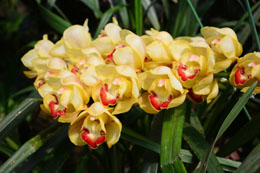Also called boat orchid, this flower is a spectacular-looking plant that comes in a variety of eye-catching colors. Let's take a look at how to care for this lovely flower.

The flower is known for its showy flowers, that are extensively used as bridal flowers and boutonnières. The blooms can range from shades of pink, red, white, cream, brown, yellowish-green, light green, and yellow. These orchids can grow up to a height of 90 cm, and depending upon the species, each flower can attain a diameter of 5-10 cm. Winter is the best time for these orchids to bloom, where a single plant can bear over 15 flowers.
Caring for a Cymbidium Orchid
Know that caring for this flower does not come easy for an average home, especially a novice. Nevertheless, the instructions are as follows:
- The plant prefers a humidity range that falls between 50-75%. So, to give the plant what it desires, you can get a tray of pebbles covered in water, and place it amidst these on the tray.
- The bottom of the plant must not sit in water and remain soggy for long periods of time, where the potting mix should not be kept bone dry, either. Watering is what distinguishes a healthy orchid from a unhealthy one. So you have to be careful about this aspect. The rule of thumb is to keep the soil moist, but not dripping wet. So how would you know about when to water it and when not to? Bury your finger one inch deep into the soil, and unearth some of it. Try to make a ball out of it. If it is able to retain its shape, then there's no need to water the plant, otherwise, it'll be a stark signal that the plant needs watering.
- The next important aspect is about the lighting. This type of orchid is adapted to most light conditions. After the plant has bloomed, place the plant where it can enjoy bright sunlight. This is required when the plant is in its growing cycle. However, prolonged exposure to the sun may damage the plant. Experts recommend placing the plant in full sunlight for about six hours in the day, and then in the shade after 12 in the afternoon. 60° F is the ideal temperature that is required during the day time, and 55° F at night.
- Use a nitrogen, phosphorus, and potassium mixture of 20-20-20 to feed the plant; too much nitrogen in a 20-10-10 mix will overproduce foliage, which won't be good for the plant's survival and upkeep.
- Another important aspect is about the type of soil required for its growth. Know that this orchid does not grow in any kind of traditional potting soil. The soil must ideally be organic in nature, where peat moss, bark compost, and the like, prove suitable. However, if you find it difficult to get a hold of these, you can go for a commercial grade orchid mix.
- It is always important to sterilize tools before repotting a plant. This is done to avoid transmitting any type of bacterial or fungal infection from an infected plant to a healthy one.






 The flower is known for its showy flowers, that are extensively used as bridal flowers and boutonnières. The blooms can range from shades of pink, red, white, cream, brown, yellowish-green, light green, and yellow. These orchids can grow up to a height of 90 cm, and depending upon the species, each flower can attain a diameter of 5-10 cm. Winter is the best time for these orchids to bloom, where a single plant can bear over 15 flowers.
The flower is known for its showy flowers, that are extensively used as bridal flowers and boutonnières. The blooms can range from shades of pink, red, white, cream, brown, yellowish-green, light green, and yellow. These orchids can grow up to a height of 90 cm, and depending upon the species, each flower can attain a diameter of 5-10 cm. Winter is the best time for these orchids to bloom, where a single plant can bear over 15 flowers.